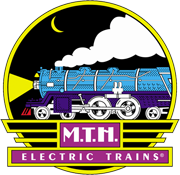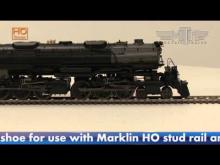Available Items

M.T.H. HO Challenger steam locomotives have begun shipping to M.T.H. Authorized Retailers. check out the engine in action by clicking on the video link to the left or the Youtube link below. The first Challengers were conceived in 1936 to replace the Union Pacific’s fleet of three-cylinder 4-12-2s. With a 50 mph top speed, the 4-12-2s had been the road’s primary fast freight engines when built in 1926. But a decade later they were considered slow and difficult to maintain. So American Locomotive Works (ALCO) was commissioned to build what became one of the most successful fleets of articulated engines on any railroad. Forty Challengers were built in the 1930s. The pressure of wartime traffic brought an order for 65 more of these 70 mph greyhounds in 1942-44, with improvements based on lessons learned from the UP’s 4-8-8-4 Big Boys. In service, the Challengers often complemented the Big Boys, speeding traffic over less rugged territory and handing it over to the Big Boys for the passage over Utah’s Wasatch Mountains.
The Challengers were steam power at its zenith. They incorporated all the technology that represented super-power steam, including roller bearings on all axles and drive rods — but none of the foolishness that characterized some of the desperate efforts to save steam in the post-war years. While most Challengers hauled freight, a number were assigned to passenger service in the Pacific Northwest, where they were converted to oil burners, equipped with smoke lifters (“wind wings” in UP parlance), and painted two-tone gray in 1946. It was in a roundabout way that six Challengers ordered by the UP ended up hauling coal for the Clinchfield Railroad. In the midst of World War II, the War Production Board refused the Rio Grande’s request to order new articulateds of its own design and instead diverted the last six Challengers in UP’s order to the D&RGW — which turned up its nose at the locos and decided to lease them for the duration and return them after the war. In 1947, the War Assets Administration sold the orphan locos to the Atlantic Coast Line and Louisville & Nashville Railroads, which put the Challengers to work on their jointly-owned subsidiary, the Clinchfield, Carolina & Ohio. Thus six engines intended to speed over western deserts and mountains ended up thundering through Appalachia. M.T.H. returns the Challenger in oil burning versions and a new technology package offering for those who prefer the AC 3-Rail Marlkin standard.
While ours is not the first HO model of this massive prototype, we believe it is certainly the best, equipped with authentic articulated sounds, including the front and rear engines going in and out of sync; actual UP whistle sounds, which can be “quilled,” just as a real engineer “plays” the whistle control; die-cast construction and optional traction tires for pulling power to match the prototype; slow-speed capability down to a steady 3 scale miles per hour; and dozens of added-on metal detail parts.







